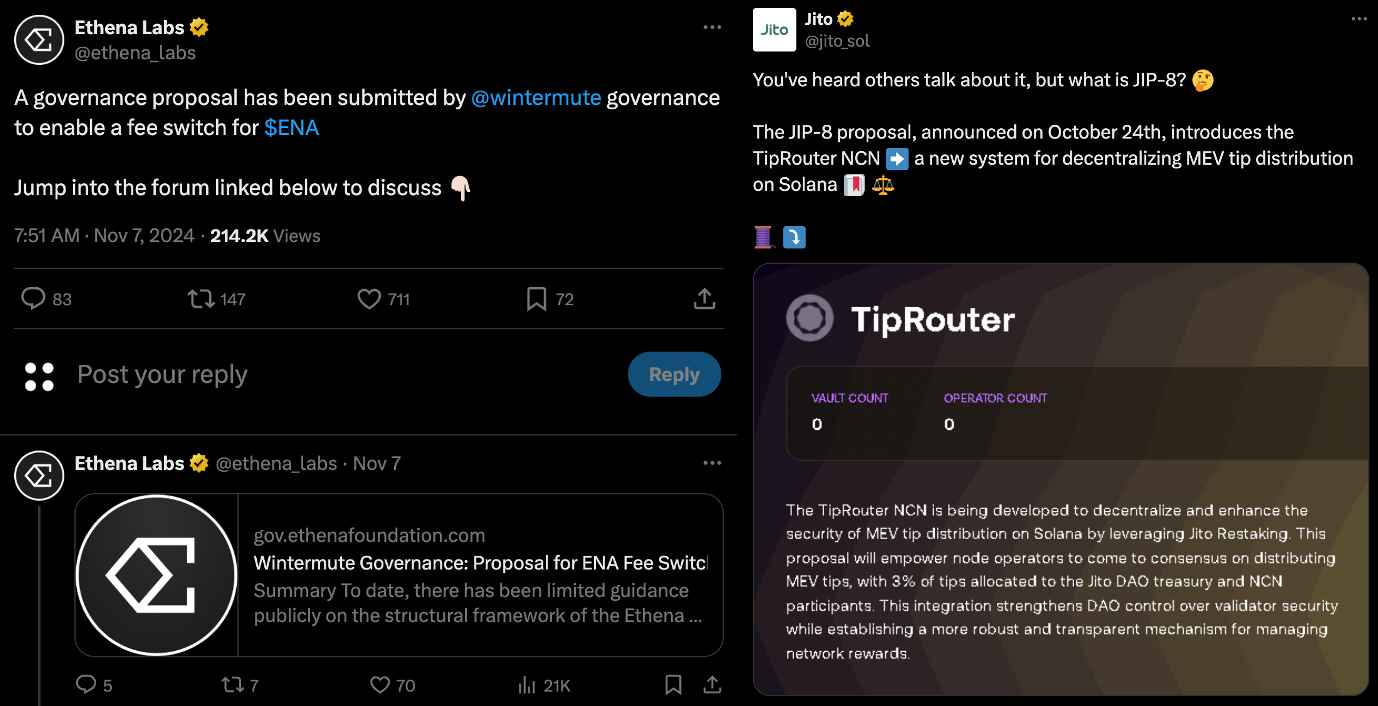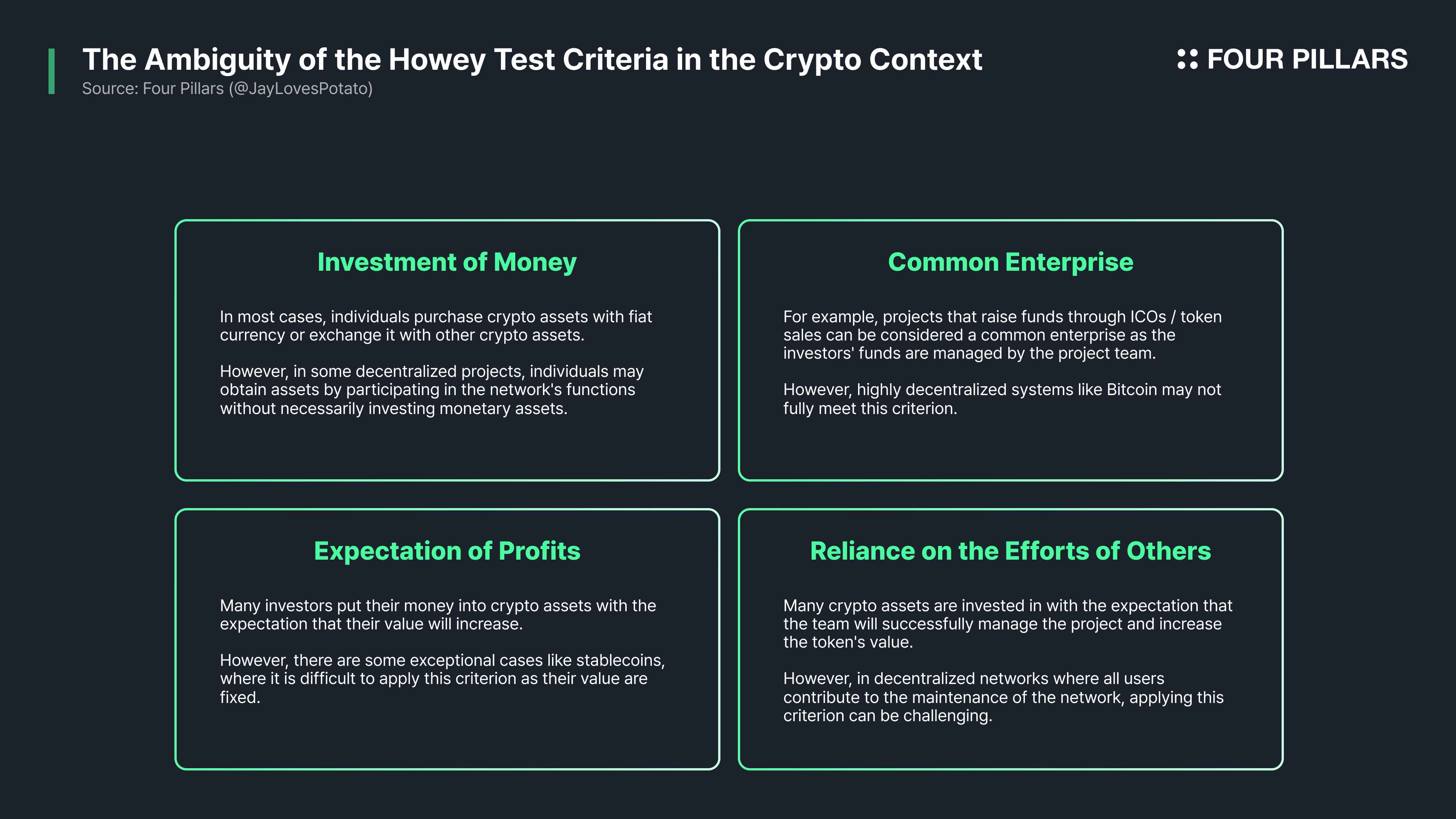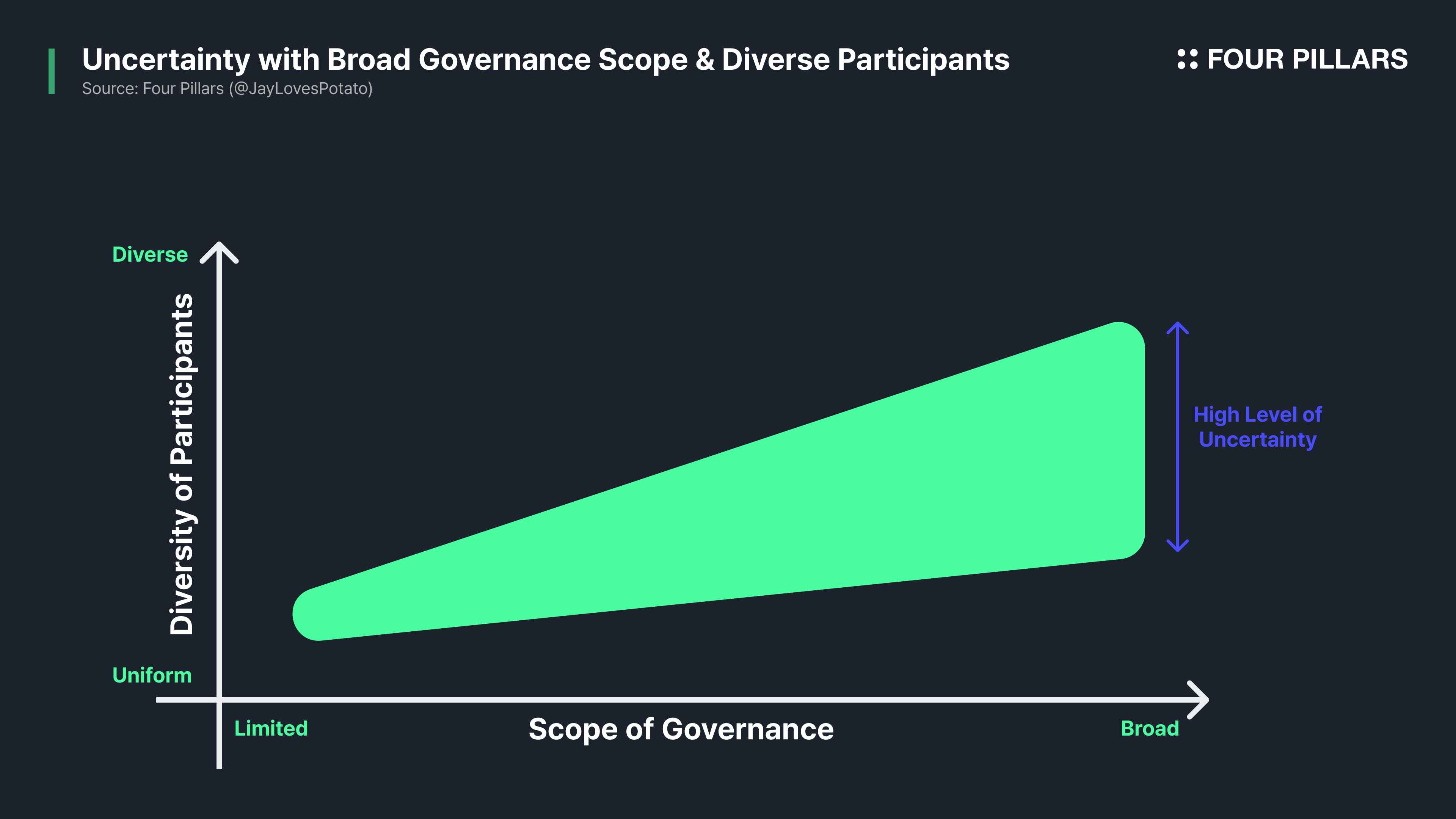By sharing platform revenue with the community, projects can strengthen their existing communities and foster a decentralized ecosystem in the long term.
This revenue-sharing mechanism typically takes one of two forms: directly sharing revenue with token holders or, as most projects currently adopt, sharing with community DAOs.
Implementing a direct profit-sharing model for token holders presents several challenges, but if public perception and regulatory frameworks for cryptocurrency evolve positively, we may see an increasing number of protocols adopting this approach for token holders.
In such cases, the roles of various players specializing in tokenomics design or protocol performance optimization, as well as the structuring of governance frameworks, will become much more important.
However, it’s crucial to recognize that introducing a revenue-sharing mechanism for token holders is not the sole factor in fostering a genuine community or driving project value. Thus, projects should incorporate a range of strategies in alignment with their goals to build a more multidimensional approach.

Source: Ethena’s Thread & Jito’s Thread
Recently on Twitter, there was significant interest surrounding Jito and Ethena. Through governance proposals, there was a suggestion to share a portion of the revenue generated by these protocols with their communities. Their goal is to strengthen existing communities and foster a decentralized ecosystem in the long term by sharing platform revenue with community members.
The Jito governance proposal suggests allocating 3% of all MEV tips generated on the Jito TipRouter protocol to the DAO treasury and NCN network participants. If approved, this governance proposal could distribute around 133.6k SOL annually to the Jito DAO.
Ethena, which generates significant revenue through the issuance of its synthetic dollar asset, USDe, was critiqued by Wintermute, a community member, for not channeling value back to ENA stakers. Wintermute proposed a framework asking whether ENA holders would be given exposure to platform revenue and, if so, how the parameters for such an initiative would be set.
Ethena, which generates considerable revenue through the issuance of the synthetic dollar asset USDe, has faced questions from Wintermute, a member of its community. Wintermute raised concerns that these revenues do not accrue value for ENA stakers directly and proposed a governance initiative to explore frameworks that could expose ENA holders to platform revenue. The proposal calls for willingness for such an initiative and setting parameters on how the initiative might be implemented.
Examining these two proposals closely reveals a subtle difference in focus regarding the beneficiaries of platform revenue. In Jito’s case, the focus is on the community-driven DAO, while in Ethena’s, it leans more towards individual token holders.
This exemplifies two distinct approaches to sharing platform revenue with the community. Many projects that share platform revenue with the community tend to adopt the DAO-based model like the one proposed by Jito, where revenue is shared with the DAO instead of distributing it directly to individual community members. This model encourages protocols to engage in various strategic initiatives with the DAO to enhance the value of the project (or token) as a whole.
The alternative approach is to directly share platform revenue with individual token holders, though there are fewer examples of this model currently in practice or under development - notable examples include GMX (DEX, revenue distribution with escrow and multiplier points), Lido (Liquid Staking, distribution of staking rewards allocated to LidoDAO with token holders), and Uniswap (DEX, distribution of protocol revenue to holders who stake or delegate their votes).
Similar to the concept of dividends in the stock market, direct revenue sharing targeted at token holders offers a clear mechanism to encourage participation in a protocol. Consequently, this approach has been anticipated as one of the effective strategies to cultivate an organic community that demonstrates a level of loyalty to the project, rather than merely engaging for speculative purposes. However, there are several reasons why such attempts have not been actively pursued.
1.2.1 Regulatory Uncertainty and Legal Risks
Due to unclear cryptocurrency regulations worldwide, adopting a mechanism that directly shares revenue with token holders could expose projects to significant legal risks. Particularly in the United States, under the Howey Test, cryptocurrencies with revenue-sharing structures could be classified as securities, potentially subjecting them to SEC regulations. If classified as securities, such tokens would face strict disclosure requirements and legal obligations, and their sale to general investors might be restricted.
As a result, many cryptocurrency projects have opted to hold off on implementing direct revenue-sharing mechanisms for retail investors until regulations become more defined. Alternatively, they often use indirect methods, such as directing revenue-sharing to a DAO treasury and allowing community DAO governance to manage it, as a way to avoid classification as securities.
1.2.2 Sustainability of the Token Economic Model
When a project shares revenue directly, it can run into operational issues if the platform’s revenue is unstable or insufficient. Especially in early stages with limited or fluctuating revenue, direct revenue sharing could quickly deplete project funds, placing a strain on long-term growth. Projects generally prefer to offer benefits to holders indirectly through the appreciation of token value itself, or to consider revenue-sharing only after the platform’s revenue model has stabilized.
1.2.3 Costs in Building Necessary Infrastructure
Revenue sharing requires a system or entity capable of continuously tracking and managing revenue, which can incur substantial costs in both technical infrastructure (e.g., developing an automated dynamic revenue distribution system) and operational management (e.g., running a risk management DAO).
1.2.4 Focus on KPIs Other Than Revenue Optimization
Some decentralized projects prioritize other key performance indicators, such as network usage and engagement, over optimizing the revenue model to distribute it to the community. These projects tend to focus on maximizing the scarcity and value of the token itself rather than revenue distribution.
2.1.1 Ambiguities in the Howey Test and Potential Changes in the Regulatory Landscape
A common characteristic among projects aiming to implement direct revenue-sharing mechanisms with token holders is that they generate a relatively meaningful level of revenue compared to other projects in the industry. As such, the main challenge these projects face in adopting revenue-sharing mechanisms primarily lies in regulatory uncertainty and legal risks, as discussed in section 1.2.
While regulatory bodies worldwide are making efforts to establish clear regulatory frameworks for cryptocurrency, as seen with the EU’s recent Markets in Crypto-Assets (MiCA) regulations, the primary regulatory concern for these protocols remains the U.S. SEC. Various developers, including Uniswap, argue that the application of the Howey Test to determine security status is ambiguous and continue to build products based on their blockchain-driven philosophy. The key points of debate regarding each element of the Howey Test are as follows:

In short, whether or not each element of the Howey Test is satisfied can vary based on the structure and degree of decentralization of the cryptocurrency. Since decentralization and autonomy in cryptocurrency exist on a broad spectrum and are difficult to measure precisely, determining whether a cryptocurrency qualifies as a security based on the Howey Test introduces ambiguity.
In practice, while the SEC has brought charges against many cryptocurrencies under securities laws, these cases have often led to prolonged legal battles or unfavorable outcomes for the SEC due to the lack of clear criteria. Such cases highlight that the SEC's current standards may not be fully applicable to cryptocurrencies, suggesting the potential adoption of new guidelines better tailored to the nature of cryptocurrencies for clearer rulings.
Additionally, the U.S. regulatory environment could change depending on the outcome of the presidential election. If a crypto-friendly candidate wins, we may see regulatory easing and growth-supportive policies for the industry, potentially benefiting tax policies related to revenue-sharing models. Furthermore, the leadership in regulatory bodies like the SEC could shift with a new administration, potentially leading to policy adjustments for cryptocurrencies. Should an industry-friendly leader be appointed, there may be a reassessment of regulations to prevent revenue-sharing models from being classified as securities, alleviating some of the regulatory tension in the industry.
2.1.2 Shifting Perceptions of Cryptocurrency
Cryptocurrencies are gaining increasing attention as alternatives to traditional investment assets or as an extended infrastructure for conventional financial assets. This positive shift in perception—spanning retail investors to institutions—toward cryptocurrencies may favorably impact the adoption of direct revenue-sharing models for token holders in the future.
Notably, recent developments such as the approval of Bitcoin and Ethereum ETFs this year, BlackRock’s launch of the BUIDL (BlackRock USD Institutional Liquidity Fund), PayPal’s issuance of a stablecoin and onboarding of the Solana Network, Stripe’s acquisition of the stablecoin infrastructure company Bridge, and optimistic reports on tokenized RWA markets from traditional financial giants like Citigroup, Boston Consulting Group, and Standard Chartered all underscore the growing interest of traditional finance in the cryptocurrency market.
If this interest continues and the integration of traditional finance with decentralized finance (DeFi) gains momentum and proves effective, more institutions will likely explore new revenue channels through cryptocurrency infrastructure. This trend could facilitate the smoother incorporation of cryptocurrencies into existing regulatory frameworks and the traditional financial sector, potentially paving the way for broader adoption of revenue-sharing models.
2.2.1 Increasing Emphasis on Tokenomics and Fundamentals
While it may seem self-evident, if the perception and regulatory environment surrounding cryptocurrencies evolve positively and more protocols adopt revenue-sharing mechanisms for holders, as previously mentioned, we may witness a shift away from the current trend where market participants rely heavily on speculative narratives. Instead, there could be an increased focus on the fundamental value and sustainability of projects.
Consequently, ongoing valuation and risk management for individual projects could become far more significant. This, in turn, may elevate the role of research entities, infrastructure providers, or other players specializing in optimizing tokenomics or performance of projects. By fine-tuning parameters that allocate limited revenue, these entities can help projects achieve two primary objectives: technological advancement of the platform and the nurturing of a genuine & organic community.
For instance, players like Gauntlet, which specialize in the economic modeling of protocols, provide performance-based dynamic parameter suggestions for protocols like Uniswap. Forgd offers comprehensive incubation services, including tokenomics design, to help projects perform at their best.
2.2.2 Increasingly Important Governance Framework Design

In the case of GMX, a revenue-sharing mechanism was introduced from the initial launch. However, for most protocols, it is likely that discussions around introducing revenue-sharing mechanisms or adjusting various parameters will occur through governance proposals during operation. Then, for protocols, one of the most crucial aspects to reconsider is designing a stable and sustainable governance framework by defining the personas of governance participants and clarifying the governance rights and scope granted to them.
If a project implements a direct revenue-sharing mechanism for token holders, the fundamental value of the token is likely to increase, potentially attracting more community members. However, if the governance framework allows all token holders to freely propose various initiatives, including revenue distribution ratios, they may flood governance proposals in an attempt to maximize their own interests, or situations may arise where they consistently disagree with each other.
In other words, this situation could hinder the stable operation of the protocol and risk delays or stalemates due to conflicts between various stakeholders. Therefore, to prevent such confusion, the protocol should appropriately structure the scope of governance agendas according to its operational goals and identify participants with the necessary expertise in each sector. This ensures the optimized operation of protocol governance.
2.2.3 Revenue-Sharing Mechanisms for Token Holders Are Not the Whole Strategy
Direct revenue sharing provides a clear mechanism through which holders can earn a share of platform revenue based on their token holdings. This has the distinct advantage of attracting various investors who seek consistent returns and fostering loyalty toward the project within the community.
However, it’s important to understand that adopting such mechanisms is not the only factor that drives community building and enhances the project’s value. Rather than merely focusing on revenue-sharing mechanisms, fundamental drivers could include investing in diverse new technologies and supporting projects backed by innovative narratives that create excitement among community members and drive token demand.
Therefore, projects should strategically balance the approach that best aligns with their product's direction: whether to provide predictable and continuous revenue distribution to investors through their product, or to focus on the advanced growth of the product itself to create demand for the token, allowing them to deploy a multifaceted strategy.
Related Articles, News, Tweets etc. :
Coindesk - Crypto Friendly SEC and Senate Banking Committee Expected Under Trump: Bernstein
Uniswap - The Fight for DeFi continues
Gauntlet - Uniswap Protocol Fee Report
Uniswap Governance Forum - Activate Uniswap Protocol Governance
GMX - GMX Docs
Lido - Lido Docs
Lido Governance Forum - Proposal: Introducing $LDO Staking
Lido Governance Forum - Activate Lido Protocol Governance with Revenue Share Staking
Jito Governance Forum - JIP-8: Adopt TipRouter NCN (Protocol Development)
Ethena Governance Forum - Wintermute Governance: Proposal for ENA Fee Switch
Related People, Projects :
Ethena ( @ethena_labs )
GMX ( @GMX_IO )
Jito ( @jito_sol , @JitoFDN )
Lido ( @LidoFinance )
Uniswap ( @Uniswap , @UniswapFND )
Gauntlet ( @gauntlet_xyz )
Wintermute ( @wintermute_t )
Dive into 'Narratives' that will be important in the next year